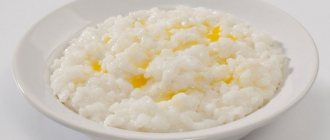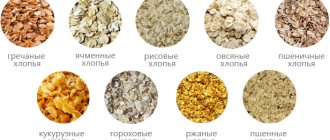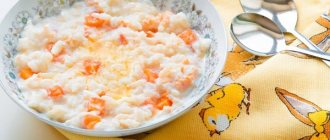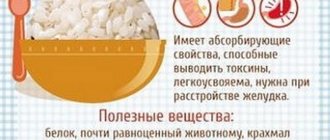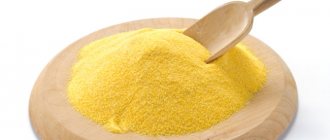The most common breakfast for children in our country is porridge. The variety of cereals from which they can be prepared is not so great, but every mother simply must be able to add delicious details and nuances to her baby’s meals. Oatmeal with milk for breakfast is one of the best options to strengthen a child’s fragile body, fill it with energy for the whole morning and give the digestive system a reason to distribute useful minerals and vitamins throughout the body. So let’s look at how beneficial it is to eat oatmeal and how it can be prepared.
The benefits of baby oatmeal
All mothers know about the beneficial properties of rolled oats for babies. Hearty and nutritious porridge contains vitamins C, B, E, PP, iron, chlorine, potassium, magnesium and other minerals. Oatmeal contains a large amount of vegetable protein, fiber and organic fats, which is beneficial for infants with digestive disorders.
Benefits of oatmeal for children:
- is an invaluable source of complex carbohydrates, so pediatricians recommend using it as a hearty and appetizing breakfast for babies;
- introducing oatmeal into a baby’s diet helps improve intestinal function;
- stimulates metabolism in the body without leading to weight gain;
- strengthens the musculoskeletal system;
- improves the condition of the endocrine system;
- accelerates the removal of harmful toxins and toxic compounds;
- normalizes cholesterol and hemoglobin levels, fights anemia;
- tidies up the functioning of the hematopoietic system;
- has a positive effect on the condition of the skin, reduces rashes;
- increases immunity.
Watch the video of Dr. Komarovsky - is oatmeal the healthiest?
Food: which porridge is the healthiest - Doctor Komarovsky
When deciding at what age a child can be given oatmeal, it is best to consult a pediatrician, since this product has a number of contraindications and can cause allergies.
From what months can a baby be fed regular porridge?
Oatmeal is very useful for the digestive system: by enveloping the mucous membrane of the stomach and intestines, it protects these organs from the aggressive effects of various substances supplied with food.
| Useful microelements and vitamins contained in porridge | Beneficial effect on the body |
| Potassium, magnesium | Have a beneficial effect on cardiovascular activity. |
| Vitamins B | Promote brain development, have a positive effect on the functioning of the nervous system, have a calming effect, improve digestion and skin condition. |
| Calcium, phosphorus | Strengthens bones. |
| Iron | Increases hemoglobin in the blood. |
| Iodine | Improves metabolism. |
| Zinc | Plays an important role in the process of building body cells, helps to better absorb B vitamins, and helps strengthen the immune system. |
| Cellulose | It has a positive effect on intestinal function and prevents constipation. |
| Antioxidants | Help strengthen the immune system, protect the body from adverse external factors. |
Despite all the usefulness of porridge, its harmful effects on the body may include the following:
- Oatmeal (as well as some other cereals) contains a vegetable protein - gluten, which often causes allergies in infants, which goes away over time. True, in some people (albeit quite rare), gluten intolerance is congenital and persists throughout life. In this case, all products containing it are excluded from the diet.
- When the starch contained in oatmeal is broken down in the body, glucose is formed, the accumulation of which with frequent consumption of porridge can lead to diabetes.
- If a child has problems with the functioning of the digestive system, then fiber, which is abundant in oatmeal, can aggravate them.
Signs of a gluten allergy may include:
- pain in the tummy after feeding porridge, accompanied by crying;
- increased flatulence;
- abnormal stool: it becomes liquid, foamy, with a pungent odor;
- the appearance of skin rashes;
- baby anxiety, sleep disturbance;
- underweight
If these symptoms appear, you should stop eating oatmeal and consult a doctor for a diagnosis.
Therefore, when answering the question whether children can have oatmeal, the child’s age and whether he is allergic to gluten are first taken into account.
Despite the benefits of oatmeal, pediatricians do not recommend starting your baby’s introduction to porridge with it. There are several explanations for this:
- high calorie content;
- the phytic acid contained in the composition washes out calcium (because of this, you should not eat oatmeal every day);
- a large amount of starch, which, when ingested, turns into sugar and increases glucose levels. Constant consumption of porridge can cause the development of diabetes.
Oatmeal is high in calories
Some children, after introducing oatmeal into their diet, experience indigestion, bloating, pain in the intestines, nausea and vomiting. These may be symptoms of fiber intolerance. In this case, you should temporarily postpone its introduction into complementary foods and consult your pediatrician.
Gluten is a plant protein found in some grains, including oats. To break it down, a special enzyme must be present in the body - aminopeptidase, which begins to be produced in the gastrointestinal tract only from 8-10 months. Until this time, gluten is a toxin that causes food allergies in many babies.
Harm of rolled oats
Baby oatmeal for babies can be not only healthy, but also harmful. Before introducing oatmeal into the diet of newborns, you need to take into account that it contains a significant proportion of gluten. A common “response” of the body to gluten-containing cereals is an allergic reaction.
An allergic reaction to the product is manifested by the following symptoms:
- painful colic in the stomach;
- bloating;
- increased gas formation;
- skin rashes accompanied by itching and swelling;
- stool disorder;
- lethargy, apathy, loss of strength.
Only a doctor can make a correct diagnosis. If allergic intolerance is detected, rolled oats can be replaced with rice, buckwheat or corn.
Hercules porridge should not be given to a child suffering from celiac disease. Hercules can increase blood glucose levels, so if you have diabetes, you can feed your child this dish no more than once every 1-2 weeks.
What are the benefits of oatmeal?
Oatmeal contains a vitamin and mineral complex that has a beneficial effect on the development and functioning of almost all systems of the child. The iodine it contains is useful for the endocrine system, iron is necessary for hematopoietic function, calcium is needed for bones, because now the baby is actively growing.
Nicotinamide and ascorbic acid support the functioning of the immune system, and vegetable protein saturates the child and improves the functioning of the gastrointestinal tract. Gentle crushing technology allows you to preserve all the benefits of the cereal, and Nestlé dairy-free porridge becomes an excellent product that not only saturates the baby, but also benefits his health.
At what age can you start giving your child oatmeal?
Up to 6 months, the baby receives all the necessary substances from breast milk or an adapted milk formula, but over time they become insufficient. That is why mothers should know at what age they can give their baby complementary foods with oatmeal porridge and how to properly add a new product to the diet.
When can you give your baby complementary foods with oatmeal:
- Oatmeal can be given to children up to one year old - a formula-fed baby at 6-7 months, but if a natural-fed child is given the first portion at 8 months.
- You can feed your baby oatmeal only when he “gets acquainted” with buckwheat, rice and other cereals.
- Baby porridge is prepared only with water; it is allowed to cook with milk only after the child turns 1 year old.
- If milk porridge is prepared for a child at 10-11 months, the milk must be diluted with water in equal proportions.
- The finished product should have a liquid, viscous consistency.
- For the first “acquaintance”, a minimum portion is given – no more than a teaspoon. If well tolerated, it can be gradually increased.
- To help the baby get used to a new dish faster, you can add a tablespoon of breast milk or the usual formula.
- It is best to treat little gourmets to oatmeal in the morning, before the main feeding.
- If the baby categorically refuses to eat a new dish, under no circumstances should you force him. It is better to remove the product from your diet for several weeks.
- Hercules complementary foods should not be given to a baby if he has a fever, feels unwell, or is about to be vaccinated.
After reaching the age of one, the child can prepare oatmeal with various additives - butter, a small amount of salt or sugar. Various fruits, berries and dried fruits are often used to prepare the dish.
For children over 2 years old, oatmeal can be combined with nuts, dried apricots and other dried fruits, yogurt, jam, honey, berries and pieces of fresh fruit. Additives can be not only sweet - kids will definitely love the delicious porridge with chicken, cauliflower, carrots, pumpkin, zucchini, asparagus, tomatoes and other vegetables.
When to introduce oatmeal into your diet?
Pediatricians recommend doing this no earlier than 5 months. If the baby has a normal or thin build and is underweight (and at 5 months he should weigh from 6.5 kg to 8 kg), then porridge is exactly the food that should be used to diversify the menu.
If the newborn is overweight, complementary feeding should start with vegetables, since they are lower in calories, but also rich in vitamins and microelements. While vegetables are introduced, the child will begin to move more, learn to sit and crawl, and will spend more energy - and this is where porridge will come in handy.
A clear sign that the baby is ready for complementary feeding is his interest in his parents' food - if he follows the spoon or fork with food with his eyes, if he opens his mouth and wants to try, this indicates that he is already old enough to taste porridge.
If the baby begins to ask for the breast more often, this also indicates that his body spends more energy than it receives, so it is necessary to introduce more nutritious foods into the menu.
It is not recommended to start complementary feeding in situations where the child:
- recently suffered from an illness,
- in a bad mood, moody, irritable.
In the first case, this may negatively affect his well-being, since a fundamentally new diet will become an additional burden for the body, which is not quite strong. In the second case, the baby will not be able to taste the food and evaluate it correctly, but in the future, the dishes from which they will try to feed it may cause negative associations.
How to choose the right porridge
Mom can cook oatmeal herself or buy a ready-made product in the supermarket. Each of these dishes has its own advantages. Homemade porridge made from natural oats does not contain any synthetic or chemical additives, and in terms of the amount of plant fiber it is significantly ahead of the store-bought product.
Ready-made industrially produced porridge is additionally enriched with vitamin and mineral components, and its preparation takes a minimum of time. The disadvantage of the product is that it is not entirely natural.
Pediatricians are confident that both homemade and ready-made porridge can be included in the diet. They can be alternated by observing the child and focusing solely on his taste preferences.
Cook it yourself or buy it?
To prepare oatmeal for a baby, you need some preliminary preparation. The cereal needs to be washed and dried. Then you need to grind it and only then cook it. It is worth noting that new products are introduced into the diet of infants gradually - start with a teaspoon, carefully observing the body’s reaction and increasing the volume daily.
It is clear that in order to prepare such a tiny amount of porridge, it is inappropriate to dirty pots and waste your time, because now in stores there is a large selection of well-proven products, for example, Nestle porridge.
How to cook oatmeal for a baby
There are many ways to cook oatmeal porridge for the children's menu. Mothers should remember that before preparing porridge for a child under 1 year of age, the cereal must be ground into flour. For this purpose, you can use a blender or coffee grinder.
On the water
To cook healthy porridge for the first feeding, grind rolled oats to a powder. For 200 ml of water you need to add 2 teaspoons of flour.
Pour water into a small saucepan and boil. After this, add the required amount of flour and bring to a boil again, stirring regularly. Simmer over low heat for 4-6 minutes and let it brew under the lid.
With milk
After mothers have introduced oatmeal with water into the children's menu, the question arises - how to properly cook oatmeal with milk for a child.
To prepare a delicious milk porridge, pour 100 ml of water into a small saucepan and bring to a boil. If desired, the liquid can be slightly salted or sweetened. After this, add 5-7 tablespoons of rolled oats, add a cup of milk and boil again.
Then cover the pan with a lid and simmer over low heat for 18-20 minutes. Add butter to the finished dish.
In a slow cooker
According to this recipe, baby rolled oats porridge is prepared using a multicooker. To do this, pour milk and water into the multicooker bowl, add the cereal and close the lid. How long to cook a dish depends on the model of the kitchen appliance; in most appliances, the timer should be set for 35-40 minutes.
Oatmeal decoction for babies
Oatmeal decoction is an effective and natural folk remedy that is given to a child if there is insufficient breast milk, regular constipation or poor weight gain. It is prepared from cereals and is approved for use for babies after 2 months. But before giving your baby any folk remedy, you should definitely consult a pediatrician.
Preparation of the decoction:
- bring 300 ml of water to a boil and add 2 tablespoons of rolled oats;
- boil the mixture for 20-25 minutes;
- pour another 100 ml of water into the liquid and simmer over low heat for 6-7 minutes;
- leave the broth to infuse, then strain through cheesecloth.
For children over 1 year old, 100 ml in the recipe can be replaced with milk; for newborns, the decoction is prepared only with water.
Read on the topic Rice porridge for babies: how to cook for the first feeding
Read on the topic Buckwheat porridge for children: how to introduce it into the first complementary foods and how to prepare it
Oatmeal is one of the most delicious, nutritious and healthy dishes in a child's diet. It improves the functioning of the digestive system, cleanses toxins, normalizes stool and improves immunity. When introduced into complementary foods in a timely manner, taking into account all the features, oatmeal will bring maximum benefits to children's health. Share link:
Did you like the article?
Average rating 0 / 5. Total votes: 0
- about the author
- Recent publications
Elena Volodina
Author of the article
Elena Volodina recently published (view all)
- Children's hematogen: at what age can it be given to a child, benefits and composition - 12/24/2020
- At what age can you give persimmon to a child: benefits, why not - 11/22/2020
- At what age can you give grapes to a child: with and without seeds - 11/13/2020
Recipe for wheat and millet porridge for a 1 year old child
Wheat and millet porridges are only similar in name, but they are prepared from different grains and in different ways. Millet porridge is prepared from millet, and wheat porridge is made from wheat. The process of preparing milk porridges using these cereals varies in duration and cooking method. To prepare these porridges you will need:
- 200 ml. milk
- 1 tbsp. cereals
- 5 g butter
- 5 g sugar or a little jam
The cooking process is very simple. Add washed cereal to boiling milk and continue cooking for a certain time. Millet porridge takes a long time to cook - about 30 minutes. And after cooking, it should stand for another 10-15 minutes. Also, during cooking, millet porridge must be stirred occasionally. Wheat porridge is prepared a little differently.


